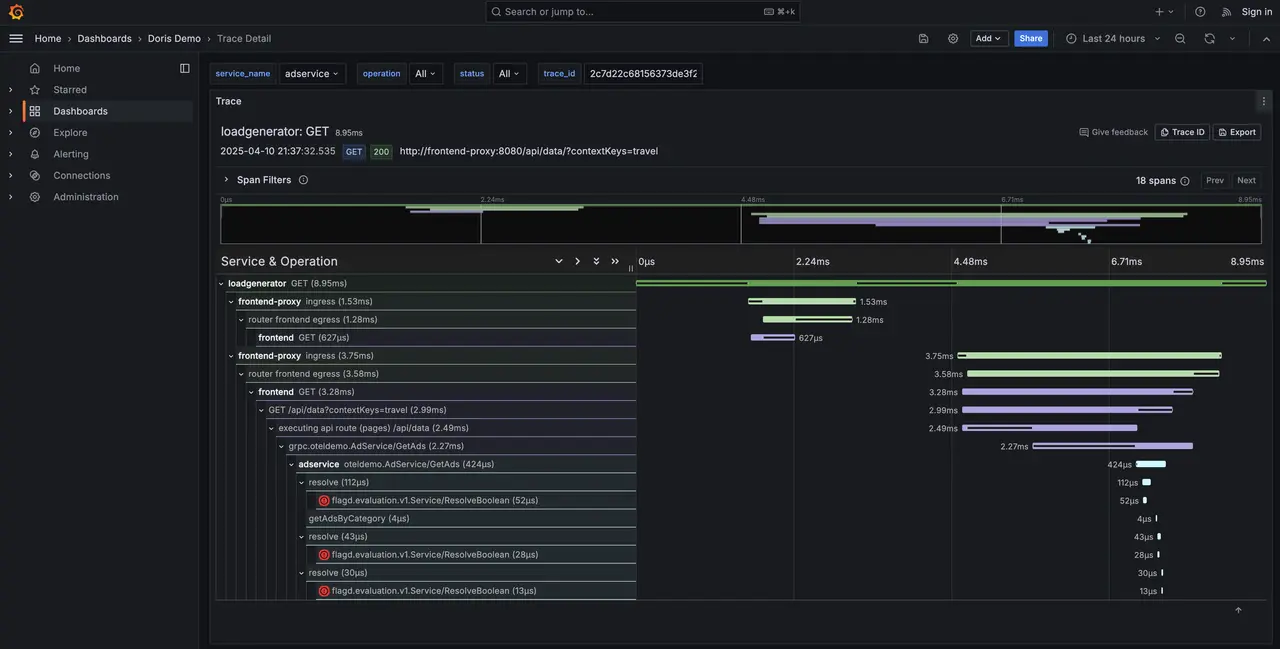Trace
This article introduces the storage and analysis practices of Trace, one of the core observability data. For an overview of the complete observability solution, please refer to Overview. For resource evaluation, cluster deployment, and optimization, please refer to Log.
1. Table Creation
Trace data has distinct characteristics in terms of writing and querying patterns. Targeted configurations during table creation can significantly improve performance. Create your table based on the key guidelines below:
Partitioning and Sorting
- Use RANGE partitioning on the time field, enable dynamic partitioning to manage partitions automatically by day.
- Use
service_nameand a time field of type DATETIME as keys; this provides multiple times acceleration when querying traces for a specific service over a certain period.
Bucketing
- The number of buckets should be approximately three times the total number of disks in the cluster.
- Use the RANDOM bucketing strategy. Combined with single-tablet ingestion during writes, it improves batch write efficiency.
Compaction
- Use the time_series compaction strategy to reduce write amplification, which is crucial for optimizing resources under high-throughput ingestion.
VARIANT Data Type
- Use the semi-structured VARIANT data type for extended Trace fields like
span_attributesandresource_attributes. This automatically splits JSON data into sub-columns for storage, improving compression rates and reducing storage space while also enhancing filtering and sub-column analysis performance.
Indexing
- Build indexes on frequently queried fields.
- For fields requiring full-text search, specify the parser parameter. Unicode tokenization generally meets most needs. Enable the
support_phraseoption to support phrase queries. If not needed, set it to false to reduce storage usage.
Storage
- For hot data, configure 1 replica if using cloud disks or at least 2 replicas if using physical disks.
- Use hot-cold tiered storage configuration with
log_s3object storage andlog_policy_3daypolicy to move data older than 3 days to S3.
CREATE DATABASE log_db;
USE log_db;
-- Not required for compute-storage separation mode
CREATE RESOURCE "log_s3"
PROPERTIES
(
"type" = "s3",
"s3.endpoint" = "your_endpoint_url",
"s3.region" = "your_region",
"s3.bucket" = "your_bucket",
"s3.root.path" = "your_path",
"s3.access_key" = "your_ak",
"s3.secret_key" = "your_sk"
);
-- Not required for compute-storage separation mode
CREATE STORAGE POLICY log_policy_3day
PROPERTIES(
"storage_resource" = "log_s3",
"cooldown_ttl" = "259200"
);
CREATE TABLE trace_table
(
service_name VARCHAR(200),
timestamp DATETIME(6),
service_instance_id VARCHAR(200),
trace_id VARCHAR(200),
span_id STRING,
trace_state STRING,
parent_span_id STRING,
span_name STRING,
span_kind STRING,
end_time DATETIME(6),
duration BIGINT,
span_attributes VARIANT,
events ARRAY<STRUCT<timestamp:DATETIME(6), name:STRING, attributes:MAP<STRING, STRING>>>,
links ARRAY<STRUCT<trace_id:STRING, span_id:STRING, trace_state:STRING, attributes:MAP<STRING, STRING>>>,
status_message STRING,
status_code STRING,
resource_attributes VARIANT,
scope_name STRING,
scope_version STRING,
INDEX idx_timestamp(timestamp) USING INVERTED,
INDEX idx_service_instance_id(service_instance_id) USING INVERTED,
INDEX idx_trace_id(trace_id) USING INVERTED,
INDEX idx_span_id(span_id) USING INVERTED,
INDEX idx_trace_state(trace_state) USING INVERTED,
INDEX idx_parent_span_id(parent_span_id) USING INVERTED,
INDEX idx_span_name(span_name) USING INVERTED,
INDEX idx_span_kind(span_kind) USING INVERTED,
INDEX idx_end_time(end_time) USING INVERTED,
INDEX idx_duration(duration) USING INVERTED,
INDEX idx_span_attributes(span_attributes) USING INVERTED,
INDEX idx_status_message(status_message) USING INVERTED,
INDEX idx_status_code(status_code) USING INVERTED,
INDEX idx_resource_attributes(resource_attributes) USING INVERTED,
INDEX idx_scope_name(scope_name) USING INVERTED,
INDEX idx_scope_version(scope_version) USING INVERTED
)
ENGINE = OLAP
DUPLICATE KEY(service_name, timestamp)
PARTITION BY RANGE(timestamp) ()
DISTRIBUTED BY RANDOM BUCKETS 250
PROPERTIES (
"compression" = "zstd",
"compaction_policy" = "time_series",
"inverted_index_storage_format" = "V2",
"dynamic_partition.enable" = "true",
"dynamic_partition.create_history_partition" = "true",
"dynamic_partition.time_unit" = "DAY",
"dynamic_partition.start" = "-30",
"dynamic_partition.end" = "1",
"dynamic_partition.prefix" = "p",
"dynamic_partition.buckets" = "250",
"dynamic_partition.replication_num" = "2", -- Not required for compute-storage separation
"replication_num" = "2", -- Not required for compute-storage separation
"storage_policy" = "log_policy_3day" -- Not required for compute-storage separation
);
2. Trace Collection
Doris provides open and general-purpose Stream HTTP APIs that can integrate with Trace collection systems like OpenTelemetry.
OpenTelemetry Integration
- Application-side Integration with OpenTelemetry SDK
Here we use a Spring Boot example application integrated with the OpenTelemetry Java SDK. The example application comes from the official demo, which returns a simple "Hello World!" string for requests to the path "/".
Download the OpenTelemetry Java Agent. The advantage of using the Java Agent is that no modifications are needed to existing application. For other languages and integration methods, see the OpenTelemetry official website Language APIs & SDKs or Zero-code Instrumentation.
- Deploy and Configure OpenTelemetry Collector
Download and extract OpenTelemetry Collector. You need to download the package starting with "otelcol-contrib", which includes the Doris Exporter.
Create the otel_demo.yaml configuration file as follows. For more details, refer to the Doris Exporter documentation.
receivers:
otlp: # OTLP protocol, receiving data sent by the OpenTelemetry Java Agent
protocols:
grpc:
endpoint: 0.0.0.0:4317
http:
endpoint: 0.0.0.0:4318
processors:
batch:
send_batch_size: 100000 # Number of records per batch; recommended batch size between 100MB-1GB
timeout: 10s
exporters:
doris:
endpoint: http://localhost:8030 # FE HTTP address
database: doris_db_name
username: doris_username
password: doris_password
table:
traces: doris_table_name
create_schema: true # Whether to auto-create schema; manual table creation is needed if set to false
mysql_endpoint: localhost:9030 # FE MySQL address
history_days: 10
create_history_days: 10
timezone: Asia/Shanghai
timeout: 60s # Timeout for HTTP stream load client
log_response: true
sending_queue:
enabled: true
num_consumers: 20
queue_size: 1000
retry_on_failure:
enabled: true
initial_interval: 5s
max_interval: 30s
headers:
load_to_single_tablet: "true"
- Run OpenTelemetry Collector
./otelcol-contrib --config otel_demo.yaml
- Start the Spring Boot Example Application
Before starting the application, simply add a few environment variables without modifying any code.
export JAVA_TOOL_OPTIONS="${JAVA_TOOL_OPTIONS} -javaagent:/your/path/to/opentelemetry-javaagent.jar" # Path to OpenTelemetry Java Agent
export OTEL_JAVAAGENT_LOGGING="none" # Disable Otel logs to prevent interference with application logs
export OTEL_SERVICE_NAME="myproject"
export OTEL_TRACES_EXPORTER="otlp" # Send trace data using OTLP protocol
export OTEL_EXPORTER_OTLP_ENDPOINT="http://localhost:4317" # Address of the OpenTelemetry Collector
java -jar myproject-0.0.1-SNAPSHOT.jar
- Access the Spring Boot Example Service to Generate Trace Data
Running curl localhost:8080 will trigger a call to the hello service. The OpenTelemetry Java Agent will automatically generate Trace data and send it to the OpenTelemetry Collector, which then writes the Trace data to the Doris table (default is otel.otel_traces) via the configured Doris Exporter.
3. Trace Querying
Trace querying typically uses visual query interfaces such as Grafana.
-
Filter by time range and service name to display Trace summaries, including latency distribution charts and detailed individual Traces.

-
Click on the link to view the Trace detail.


